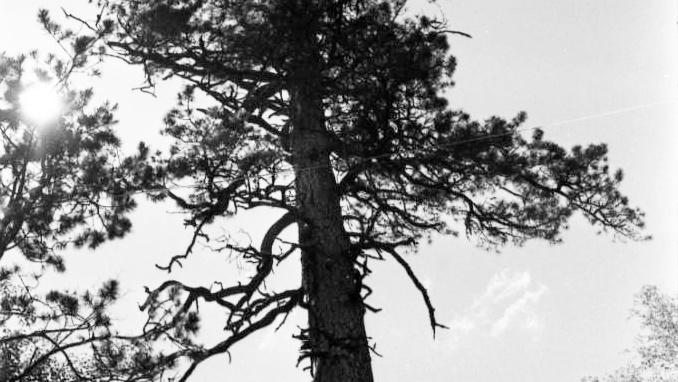If we lived in California, where Sequoia trees are part of a landscape of gigantic trees, we wouldn’t think that a 122-foot-tall tree was anything special. But when we come across a 122-foot-tall Lodgepole Pine in South Dakota, that is something special. Such a tree did exist in the center of the Black Hills, located in a place called Herbert Draw in the Black Hills National Forest a few miles from the town of Custer.
This enormous tree was completely unique in its size, growing in an area of much smaller evergreens that commonly grow from 25 to 45 feet tall. Forest Service experts who measured the tree confirmed the 122-foot height and estimated that it was over 400 years old at the time of measurement. After Mountain Pine Beetles killed the big tree in 1972, experts counted the rings on the trunk and confirmed that it was indeed just 3 years shy of being 400 years old.
History buffs like to do timeline comparisons when opportunities present themselves, especially when the object being presented for comparison is as unique as a once-living thing of incredible age.
The seedling probably emerged from the earth and started growing in 1575. So, in terms of American history, it started growing just 83 years after Columbus ‘discovered’ America, and just 10 years after the founding of St. Augustine, Florida, America’s oldest European-settled city.
The tree was about 30 years old when English colonists established Jamestown in Virginia. It was 45 years old when the Pilgrims landed at Plymouth Rock.
In 1675, when the tree was 100 years old, alliances of Native Americans and European colonists were waging war on one another in America’s northeastern colonies. Spain’s New World empire was expanding northward, beyond Mexico and into the southern and western United States.
When the tree was 200 years old, America was preparing to declare its independence from England. European/American explorers and adventurers were still blazing trails in the American West and fur trappers and traders were working nearly from coast-to-coast.
When the tree was 300 years old, a military expedition led by George Armstrong Custer entered the Black Hills, gold was discovered, and the towns of Custer and Deadwood were established.
The life of the Herbert Draw lodgepole pine continued while historical events marked the calendars – world wars, modern inventions, and men walking on the moon.
Many experts believe that Native Americans may have been responsible for bringing Lodgepole Pine seeds or small transplants to the Black Hills from the Big Horn Mountains of Wyoming, where Lodgepole trees were abundant. Lodgepole wood was a favorite choice for teepee supports. Because the trees grow tall with suitably long branch-free trunks, they’re easier to work with and provide a smoother surface where the wood contacts the hide or other material of a teepee or lodge's covering.
A cutaway of Herbert Draw Lodgepole Pine’s trunk is on display at the U.S. Forest Service Headquarters in Rapid City.
Learn more about South Dakota's tallest trees. (South Dakota Department of Agriculture.)






